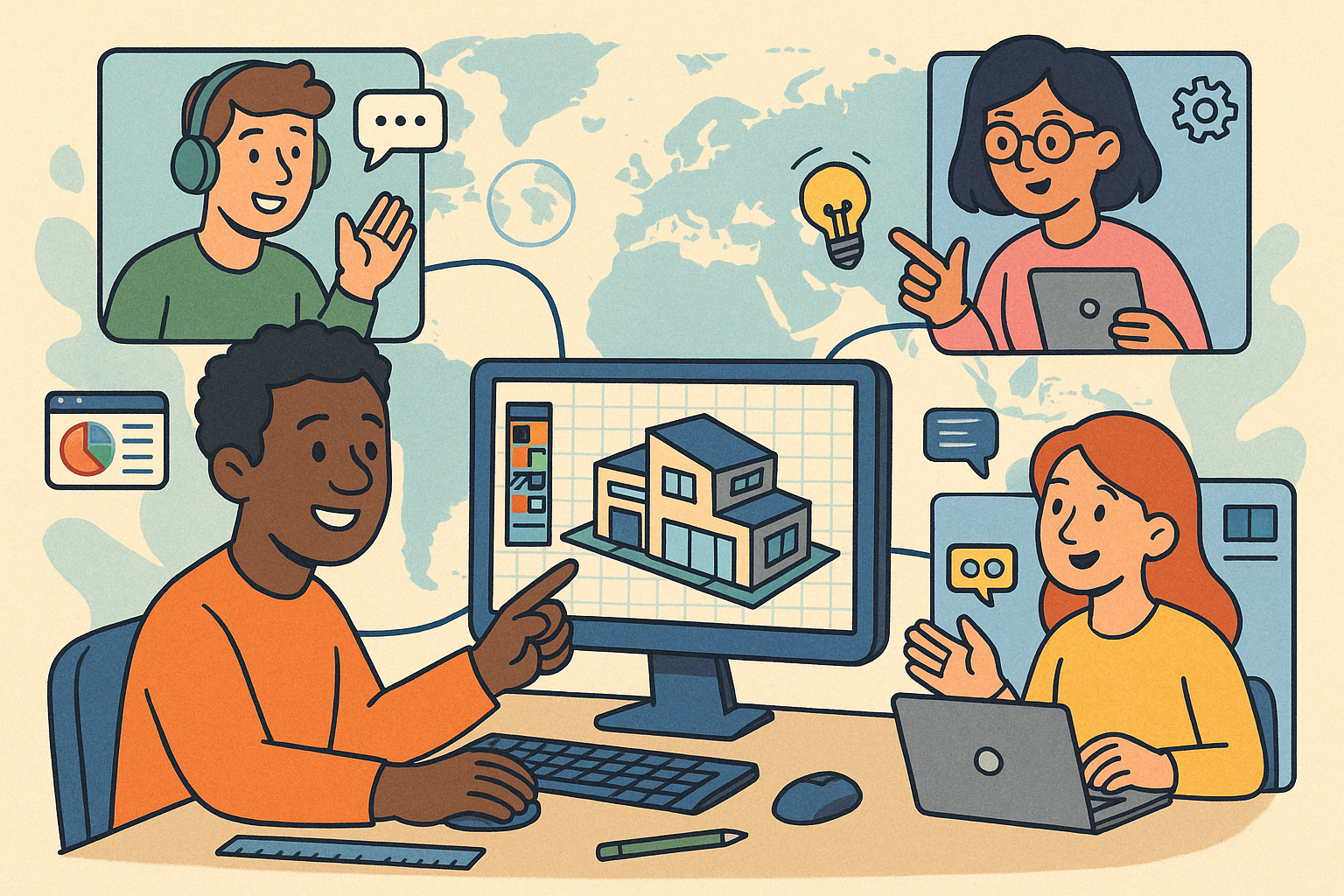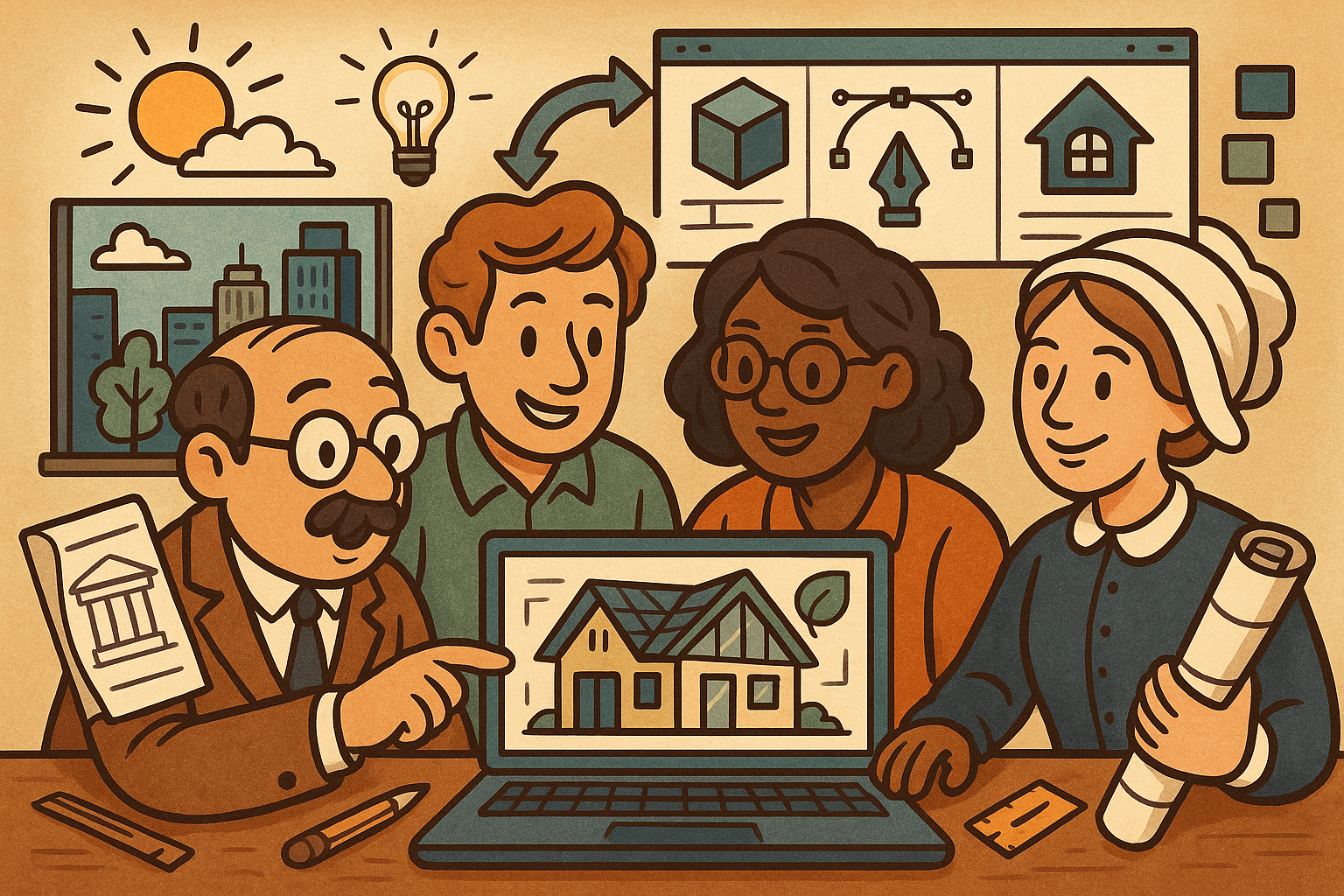Your Cart is Empty
Customer Testimonials
-
"Great customer service. The folks at Novedge were super helpful in navigating a somewhat complicated order including software upgrades and serial numbers in various stages of inactivity. They were friendly and helpful throughout the process.."
Ruben Ruckmark
"Quick & very helpful. We have been using Novedge for years and are very happy with their quick service when we need to make a purchase and excellent support resolving any issues."
Will Woodson
"Scott is the best. He reminds me about subscriptions dates, guides me in the correct direction for updates. He always responds promptly to me. He is literally the reason I continue to work with Novedge and will do so in the future."
Edward Mchugh
"Calvin Lok is “the man”. After my purchase of Sketchup 2021, he called me and provided step-by-step instructions to ease me through difficulties I was having with the setup of my new software."
Mike Borzage
Advancing Virtual Collaboration: Redefining Global Design Teams with Digital Innovation
October 24, 2025 12 min read


Setting the Stage for Virtual Collaboration – Evolving Design Landscape and Global Teams
In today’s fast-changing design industry, the evolution of digital technologies and the expansion of global networks have redefined how design teams collaborate and innovate. The traditional methods of in-person meetings and localized workspaces are continuously giving way to digital environments that not only transcend geographical boundaries but also harness the potential of modern connectivity. This development is especially significant in the context of **virtual collaboration**, where teams composed of experts from different corners of the world now contribute to the design process in real time. This paradigm shift has introduced new complexities and opportunities steering design practices towards more decentralized yet integrated operations. The increasing prevalence of remote design professionals working in varied time zones and diverse cultural contexts necessitates a rethinking of collaborative strategies. As companies expand their horizons and tap into global talent pools, the demand for systems that provide real-time connectivity, shared interactive workspaces, and mutual accountability has surged in importance.
Evolving Industry Challenges and Opportunities
This transformative journey has provided fertile ground for the development of innovative virtual platforms that help streamline complex design projects. By leveraging cloud-based solutions and interactive dashboards, teams have the flexibility to share ideas, feedback, and design iterations without being hindered by time or space constraints. Key features such as **real-time 3D editing** and augmented reality tools have advanced design communication, ensuring that every participant remains aligned with project goals. The challenges of coordinating across multiple time zones have fostered innovations in asynchronous collaboration, where contributors can review, update, and refine design elements at their own pace while maintaining overall project momentum. Moreover, the emergence of secure communication channels and structured workflow processes has enhanced team transparency and accountability, ensuring that creative processes are both fluid and robust. With an eye on future technological advancements and growing global interconnectivity, the design landscape is set to experience radical shifts that emphasize flexibility, creativity, and inclusiveness.
Setting the Stage for Virtual Collaboration – Addressing Geographical and Time-Zone Challenges
Design teams today are frequently dispersed across continents, which presents both challenges and unique opportunities for innovation. Because designers and engineers operate according to local times and schedules, aligning work processes across different regions requires dedicated strategies that ensure effective communication and collaboration throughout every stage of the design lifecycle. The need for a dedicated virtual environment has driven the creation of advanced tools and collaborative platforms that support asynchronous as well as synchronous interactions. These tools are tailored to help mitigate challenges such as delayed feedback loops, miscommunication, and project fragmentation. Using **secure communication channels** and cloud-based workspaces, teams can share updates, manage iterative design modifications, and perform collaborative editing in a manner that respects the diversity of local working practices while enabling seamless global teamwork. The emergent virtual solutions enhance project timelines by ensuring that even if team members cannot work simultaneously, a structured approach to data exchange and design reviews keeps the project moving consistently forward.
Strategies for Overcoming Global Collaboration Barriers
Breaking down complex challenges into manageable steps is imperative in the current design context. Several strategies help alleviate some of the inherent difficulties of coordinating across geographies:
- Implementing overlapping working hours where possible to synchronize critical phases of the design review process.
- Utilizing digital tools that facilitate asynchronous updates and real-time notifications to bridge the gap between different time zones.
- Investing in robust workflow designs that include version control systems and interactive dashboards to ensure consistency and clarity in collaborative projects.
Setting the Stage for Virtual Collaboration – Reshaping Team Dynamics and Creative Processes
Virtual design environments have reimagined teamwork by reshaping not only the logistical aspects of collaboration but also the intrinsic creative processes that drive innovation. In modern design settings, creativity is no longer confined to boardrooms or single locations. Instead, collaborative design efforts flourish in digital spaces that promote ongoing dialogue, the sharing of iterative design drafts, and dynamic modeling sessions that benefit from a wide array of perspectives. This environment fosters an agile and rapidly responsive design approach, where ideas can be refined and feedback integrated almost instantaneously. When teams harness virtual collaboration tools, they are better positioned to combine different areas of expertise, where the complexity of creative challenges can be tackled with a broad spectrum of insights from various disciplines. The roles within these teams may evolve from static, isolated functions into more fluid, interconnected parts of the design ecosystem, thus creating a vibrant and democratic arena for creative expression. The integration of technologies such as **cloud-based workspaces** plays a pivotal role in enabling these fluid interactions, reinforcing the modern ethos of inclusiveness and collective creativity.
Enhancing Creative Collaboration Through Digital Platforms
In addition to logistical improvements, digital platforms require a rethinking of collaborative ideation and execution. The following aspects help enhance creative collaboration in a virtual setting:
- Interactive and shareable dashboards that provide visual representations of project progress.
- Simultaneous multi-user access to design files, enabling simultaneous, distributed creative input.
- Regular virtual brainstorming sessions and iterative design challenges that harness the strengths of each team member.
Key Technologies and Features – Cutting-Edge Tools for Virtual Collaboration
At the core of effective virtual collaboration are the advanced tools and technologies that bring remote teams together in a cohesive and efficient manner. Modern design software now integrates powerful **real-time 3D editing** capabilities that allow multiple users to interact with complex models simultaneously. These features, combined with the reliability of cloud-based workspaces, offer an unprecedented level of interactivity and accessibility that transcends traditional confines. In addition to these technological innovations, the integration of virtual reality (VR) and augmented reality (AR) has transformed how designers visualize and modify digital prototypes. VR and AR tools create immersive experiences that replicate the tactile feedback and spatial understanding of physical environments, thereby enabling design teams to evaluate ergonomics, aesthetics, and functionality in a collaborative digital setting. These capabilities are not just enhancements of the user interface but rather critical components that underpin the future of remote, collaborative design practices.
Enhancing Collaboration Through Advanced Digital Tools
The evolution of these technologies reflects a trend toward more integrated digital ecosystems that support end-to-end design workflows. Among the wide array of features offered by these modern platforms, several stand out:
- Real-time multi-user editing that enables synchronized modifications across multiple devices.
- Cloud-based storage and file management systems that ensure data integrity and accessibility.
- Virtual meeting rooms enhanced with immersive VR experiences designed for collaborative design reviews.
Key Technologies and Features – Essential Features for Effective Collaboration
While cutting-edge technologies form the backbone of virtual design platforms, certain essential features are equally crucial to ensure smooth and effective collaboration. Interactive dashboards, advanced version control systems, and **secure communication channels** are indispensable components that allow teams to maintain consistency and clarity across multifaceted design projects. Interactive dashboards provide real-time insights into data and design progress, empowering team members to track changes, identify bottlenecks, and remain aligned with project goals at every step. Meanwhile, robust version control solutions help manage iterations or tweaks, ensuring that every change is documented and can be reverted if necessary, thereby safeguarding the integrity of the design process. Secure communication channels, on the other hand, play a vital role in facilitating confidential exchanges of sensitive information between remote collaborators. These features, when integrated effectively with the broader suite of digital design tools, create a deep, interconnected workflow that supports both micro-level adjustments and macro-level project management.
Integrative Workflow and Communication Mechanisms
The holistic integration of these features not only improves task efficiency but also elevates the overall design experience by fostering seamless interaction among diverse team members. Some of the notable mechanisms include:
- Interactive dashboards that aggregate project metrics and visual data for comprehensive performance tracking.
- Version control systems that maintain rigorous change logs and support rollback functionalities across collaborative sessions.
- Secure communication networks that utilize encryption protocols and authentication measures for safe data transfer.
Key Technologies and Features – Integration of Design Software with Collaborative Platforms
A fundamental aspect driving the modern design revolution is the seamless integration of specialized design software with collaborative digital platforms. This integration creates a unified ecosystem where data flows effortlessly between individual design tools and group collaboration environments. By ensuring that design software is fully interoperable with cloud-based workspaces and interactive dashboards, engineers and designers are able to work within their specialized domains while still contributing to a collective project vision. This cohesion is essential for avoiding data silos and reducing workflow interruptions, which are common issues in traditional design settings. Relying on integration capabilities ensures that every update or modification from one part of the team is reflected accurately across the collective workspace. Such interoperability not only reduces errors and redundancies but also speeds up the feedback loop, facilitating rapid iteration cycles that drive innovation forward. The result is a comprehensive, deeply interconnected digital workspace that blends the best of design software with the collaborative utility of modern virtual platforms.
Ensuring Data Consistency and Workflow Continuity
Several practical approaches underline the successful integration of design software with collaborative platforms:
- Utilizing APIs that facilitate seamless data exchange between disparate software applications.
- Implementing cloud-based project management tools that automatically synchronize design updates across multiple devices.
- Adopting cross-platform compatibility standards to ensure that tools communicate effectively, regardless of the underlying architecture.
Implementation Strategies and Best Practices – Integrating Virtual Collaboration into Existing Workflows
The transition to virtual collaboration spaces within an organization’s design workflow requires a well-thought-out strategy that integrates new technologies with established processes. Implementation often begins with a thorough evaluation of the existing design methodologies and the identification of areas where digital transformation can yield significant improvements. This evaluation is typically followed by a phased rollout that includes pilot testing, full integration, and post-deployment adjustments. It is imperative that key stakeholders across all levels are involved in the planning and execution phases to ensure buy-in and to allow for the addressing of unique challenges that may arise during the integration process. The inclusion of **cloud-based workspaces** and real-time collaboration features must be matched with training programs, updated protocols, and an iterative feedback loop that continuously optimizes the workflow. In addition, establishing clear communication channels and enforcing strict data security measures are vital to the successful deployment of these advanced virtual collaboration tools.
Phased Rollout and Stakeholder Engagement
Key steps for effective integration include:
- Conducting a comprehensive needs assessment to determine the most beneficial tools and technologies for your design team.
- Rolling out changes in phases to manage risk and ensure that each transition phase is evaluated and refined based on feedback.
- Engaging key stakeholders, including designers, engineers, project managers, and IT specialists, to foster a collective vision for digital transformation.
Implementation Strategies and Best Practices – Managing Cross-Functional Teams and Smooth Communication
When integrating modern virtual collaboration platforms into existing workflows, one of the most critical challenges is managing cross-functional teams that may have differing expectations and methods of working. In a digital workspace, maintaining smooth and effective communication requires a combination of practical strategies and the disciplined use of advanced digital tools. Teams often benefit from a structured communication plan that outlines meeting schedules, key performance indicators, and designated communication channels that are optimized for clarity and security. For example, the use of interactive dashboards coupled with real-time change tracking ensures that every team member is aware of project progress and any modifications introduced during collaborative sessions. The approach fosters an environment where feedback is shared openly and project adjustments can be implemented swiftly. In this context, regular virtual stand-up meetings and periodic reviews help in aligning objectives and mitigating misunderstandings caused by geographical separation and asynchronous communication practices. The commitment to detailed documentation and systematic workflow management further enhances the effectiveness of virtual collaboration in facilitating seamless communication.
Tools and Tactics for Effective Team Management
Several best practices serve to bolster cross-functional collaboration in a virtual environment:
- Establishing regular check-ins and virtual meetings to ensure a continuous exchange of ideas.
- Deploying centralized project management platforms that document task assignments, deadlines, and project milestones.
- Emphasizing the importance of clear, structured messaging through designated communication protocols and the use of secure, dedicated channels.
Implementation Strategies and Best Practices – Overcoming Common Challenges
Transitioning to virtual collaboration platforms introduces several technical and organizational challenges that must be effectively managed to ensure a smooth changeover. Among these, data security concerns, tool adoption barriers, and training requirements are particularly pressing. With the rapid digitization of design workflows comes the increased risk of data breaches and unauthorized access, emphasizing the need for stringent security protocols and encrypted communication pathways. Additionally, as new tools are introduced to enable these modern workspaces, there is often an inherent learning curve that can slow down initial adoption. Addressing these challenges involves a multifaceted approach that includes comprehensive risk assessments, tailored training programs, and ongoing technical support to assist team members during the transition. Organizations that invest in robust cybersecurity measures and commit to continuous employee education tend to experience a smoother integration process, thereby minimizing potential disruptions in the workflow. This integrated approach ensures that all members, from senior designers to new recruits, are well equipped to navigate the complexities of a virtual collaboration environment.
Strategies to Mitigate Data Security and Adoption Barriers
Effective methods to overcome these challenges include:
- Implementing multi-factor authentication and encryption protocols to safeguard data integrity.
- Providing comprehensive training modules and ongoing technical support to facilitate smoother adoption of new tools.
- Encouraging a culture of continuous improvement and open communication where feedback is valued and integrated into strategic planning.
Conclusion – Recap of Benefits and Future Outlook for Virtual Collaboration
The extensive implementation of virtual collaboration spaces has created transformative opportunities for global design teams to enhance their creativity, productivity, and overall project efficiency. Embracing centralized digital workspaces that incorporate **virtual collaboration**, **cloud-based workspaces**, and real-time 3D editing, teams can overcome geographical limitations and time-zone challenges while fostering a creative ecosystem that nurtures innovation from diverse viewpoints. This integrated approach not only allows for faster iterations and improved design accuracy but also builds a foundation of secure data management and streamlined communication that is essential in today’s digital-centric design environment. The progression towards virtual collaboration is set to continue, powered by ongoing technological advancements that promise even greater enhancements in how collaborative design is executed. Organizations adopting these systems are witnessing improved cross-functional cohesion, accelerated project timelines, and higher quality outputs as they navigate a rapidly evolving technological landscape.
Fostering a Creative and Inclusive Digital Workspace
Looking ahead, it is clear that virtual collaboration will continue to be a driving force in the design industry. The trend toward increasingly integrated digital workspaces is expected to create new opportunities for synergy among teams that operate in disparate locations. Future software innovations are likely to incorporate more intuitive user interfaces, enhanced AI-driven analysis, and further secure communication features that collectively streamline complex design processes. As global design teams adapt to these changing dynamics, it becomes increasingly important to invest in continuous professional development and to remain agile in the face of new technological challenges. Organizations that successfully blend the benefits of virtual collaboration with traditional design methodologies will be well-positioned to lead the market, driving creative excellence and demonstrating the immense potential of digital innovation in the design ecosystem.
Also in Design News

Design Software History: Historical Innovations in Design Software: Paving the Path to Sustainable Architecture Through Technology and Collaboration
October 24, 2025 13 min read
Read More
Cinema 4D Tip: Mastering the Timeline for Enhanced Animation Precision in Cinema 4D
October 24, 2025 3 min read
Read More
Bluebeam Tip: Maximize Document Security and Consistency with Bluebeam Revu's Flatten Tool
October 24, 2025 2 min read
Read MoreSubscribe
Sign up to get the latest on sales, new releases and more …


